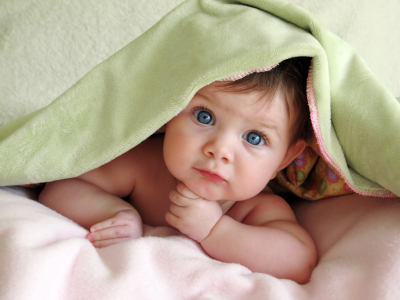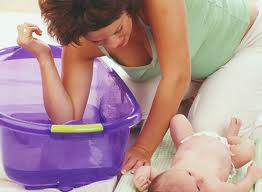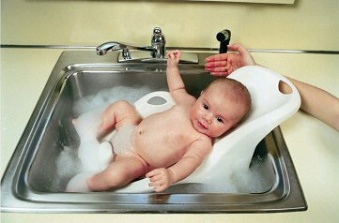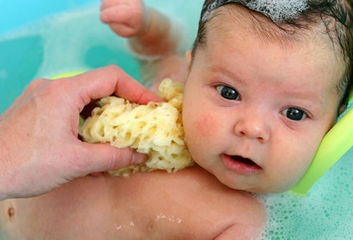Newborn Bathing Practices
Contents
Learning Objectives
1. The learner will be able to recognize and recall the preferred method for carefully and effectively bathing a newborn.
2. The learner will be able to explain the reasoning behind the method, summarizing what they learned in their own words.
3. The learner will be able to differentiate between safe and unsafe water temperatures and other bathing practices for the newborn.
4. The learner should be able to demonstrate their skill and complete a knowledge check regarding the information they have learned.
5. The learner will be able to generate a plan to implement this knowledge into the routine care of their newborn.
Pre-Test
This assessment is to determine your previous knowledge regarding newborn bathing. By the end of this module you will be able to answer these questions with ease!
1. When bathing your baby, should you use a mild liquid cleanser, or water alone?
2. How often should you bathe your baby after the umbilical cord falls off?
3. What is the maximum time you should bathe your baby for?
4. What should the room temperature be when you are giving your baby a bath?
5. What temperature should your infant have prior to giving them a bath?
6. What is the best method for drying your baby post bath?
7. True or False: You can leave your baby unattended if they are secure in a bath seat.
Newborn Skin pH & Skin Integrity
A newborn’s skin is an important barrier to many pathogens as well as protects the infant from water loss. The pH of the newborn skin is approximately 6.4 at birth and then drops to 4.9 in the following three to four days. Maintaining the skins pH balance is essential to keeping its integrity (Lavender, et al., 2009). New evidence suggests that the skin barrier continues to develop up to twelve months following birth (Blume-Peytavi et al., 2009).One of the most controversial topics concerning newborn bathing has been whether to use plain water or liquid cleansers. Evidence for water only stems from research that some soaps and detergents can alter the pH of the skin by raising the pH from a normal 5.5 to 7.5 or greater. Proteases on the skin are pH sensitive enzymes and will work best in a range of 7.5 to 8.0. By using a soap or liquid cleanser which raises the pH of the skin, the enzyme activity will increase thus leading to greater skin breakdown (Lavender et al., 2009). However, water alone has been associated with skin dryness as well as the fact that used alone; it is a poor cleanser for ridding harmful bacteria off the skin (Adam, 2008). These bacteria such as fecal enzymes can lead to nappy rash (Blume-Peytavi et al., 2009).
Recommendations
- Use a mild liquid cleanser
- Liquid cleaners which contain emollients can provide further protective effects on the newborn's skin
- Cleanser should not irritate the skin or the eyes, nor alter the pH of the skin
- Soap free liquid varieties should be chosen over those which contain soap
- Liquid cleansers should contain adequate and appropriate preservatives
- Parents and others who care for the newborn should always read the product instructions
- Contact health care provider if changes in newborn's skin occur after use of a certain product
Bath Water Temperature & Newborn Thermoregulation
How does the newborn stay warm?
An understanding of the physiological thermoregulation capabilities of the newborn is imperative to administering a proper newborn bath, especially when determining an appropriate bath water temperature. The healthy newborn baby keeps itself warm through three mechanisms: alteration of body position, vasoconstriction, and non-shivering thermoneogenesis. When the newborn senses a drop in core temperature, it will flex the extremities and bring them closer to the trunk in order to conserve heat by reducing surface area. Vasoconstriction will occur in response to cold as the sympathetic nervous systems signals the peripheral vasculature to constrict, thus reducing blood flow to the skin and subsequent heat loss through conduction. The infant’s primary mechanism of preventing heat loss, however, is heat production by non-shivering thermoneogenesis. This mechanism consists of the hypothalamus detecting a drop in body temperature and signaling the metabolism of mitochondria-rich brown adipose tissue, which results in the release of heat. These mechanisms allow the healthy newborn baby to maintain a body temperature of 36.5 to 37.2 °C (97.7 – 98.9 °F). =
Recommendation
- A healthy newborn baby's body temperature is 36.5 to 37.2 °C (97.7 – 98.9 °F).
What Happens if the Bath Water is Too Hot or Too Cold?
There are serious implications to bathing the newborn with bath water that is either too hot or too cold. A bath that is too hot can scold the newborn’s skin leading to compromised skin integrity . The basin should be filled with water that feels warm, not hot, to the inside of the bather’s wrist or elbow. A thermometer can be placed in the bath to check water temperature, if desired. The water heater on the faucet can also be set to a maximum of 48.8°C (120 °F) for added precaution. Bath water that is too cold can cause a significant drop in the newborn’s body temperature. In the event of hypothermia, which is a temperature of less than 35 °C (95°F), the newborn will experience cold stress. Cold stress is a condition in which heat loss exceeds the newborn’s ability to produce heat through non-shivering thermoneogenesis, and core body temperature cannot be sustained. Signs and symptoms include lethargy, muscle weakness, weight loss, restlessness, increased breathing rate, difficulty breathing and pale skin color. Prolonged cold stress will cause hypoxia (a lack of oxygen to the newborn's tissues), hypoglycemia (low blood sugar), and possible heart damage.
Recommendations
- Bath water that is too hot will scald the newborn's skin
- Bath water that is too cold will cause cold sress, a condition than can lead to hypoxia (lack of oxygen in the tissues) and hypoglycemia (low blood sugar)
- Signs of cold stress include lethargy, pale skin color, difficulty breathing, and restlessness
What Temperature Should the Bath Water Be?
In order to prevent both cold stress and scalding during the newborn bath, water temperature should be kept close to body temperature at 37 - 37.5 °C (98.6-99.5 °F). Before the newborn is placed into the bath, the water should be mixed to ensure even heat distribution. The nurse or parent must make sure that the newborn’s (axillary) temperature is stable (a minimum of 36.5 °C or 97.7 °F) before proceeding with the bath. In addition, the area should be absent of drafts and room temperature should be a minimum of 21 - 22 °C (69.8 - 71.6 °F) throughout the bath.
Recommendations
- Bath water temperature should be maintained between 37 - 37.5 °C (98.6-99.5 °F)
- Bath water should be mixed prior to placing the newborn in the tub to ensure even heat distribution
- Room temperature should be a minimum of 21 - 22 °C (69.8 - 71.6 °F) and there should be no drafts
- Always make sure the newborn's temperature is at least 36.5 °C (97.7 °F) before administering a bath
How Do You Prevent Hypothermia During the Bath?
Once the newborn is placed in the bath tub, further interventions can be employed to prevent heat loss during the bath. Newborns lose body heat through several mechanisms but the one that is most pertinent during the newborn bath is heat loss through evaporation as water dries from the body surface. For safety reasons, the basin should be filled with about two inches of water so that most of the newborn’s body and face are well above the water level, but water can be poured over the newborn’s body frequently to keep the newborn warm or a wash cloth can be placed over the newborn’s abdomen and chest to limit exposure to ambient air. The recommended bath length is five to ten minutes. This is plenty of time to thoroughly clean the newborn without leaving them exposed in the water for too long, as the water will rapidly cool. Following the bath, the newborn should immediately be covered, pat dry, and dressed because the newborn is extremely vulnerable to heat loss at this time.
Recommendations
- Water can be poured over the newborn’s body frequently
- A wash cloth can be placed over the newborn’s abdomen and chest to limit exposure to room air
Tub vs. Sponge Bath: Which Should You Choose?
A tub bath is the preferred method over cloth or sponge washing because it is associated with less heat loss than cloth washing. An added benefit is that tub bathing promotes relaxation of the newborn, and it is the perfect environment for mother-baby or father-baby bonding.
Recommendations
- Tub bathing is associated with less newborn heat loss
- Tub bathing promotes bonding between parent and child.
Frequency of Bathing
Evidence has shown that the bathing of newborns can be done routinely and without harm (Blume-Peytavi et al, 2009). Below are recommendations for the frequency and timing of the newborn bath based on the latest evidence regarding newborn skin integrity and thermoregulation (see above).
Recommendations
- Bathing may begin before or after the unbilical cord has fallen off, however waiting until the cord has fallen off has been associated with some advantages for the newborn
- Bathing should occur 2-3 times per week until the newborn is crawling
- The bath should last approximately 5-10 minutes.
Safety Precautions
- Be prepared; have all of your supplies at hand so you won't need to step away.
- Always check water temperature before placing your baby in the tub.
- Keep the bath under 10 min. to reduce cold stress.
- Never leave your newborn unattended in a bath, even if the child is sitting in a bath chair.
- If you have to step away, take your baby with you.
- Never let the water run while your baby is in the tub, the temperature could change; resulting in burns or cold stress.
Post-Test (See Answers Below References)
1) How should I check the bathwater to insure that the temperature is appropriate?2) What type of cleanser should I use when washing my baby?
3) How often should my baby have a bath?
4) True or False: I should fill the tub with enough water to immerse my baby completely.
5) Hypothermia is when my baby’s temperature is too...?
6) What is the proper temperature for my baby’s bath water?
7) How long should it take to bathe my baby?
References
Adam R. (2008). Skin Care of the Diaper Area. Pediatric Dermatology 25(4): 427-33
Ajzen, I. (2006). Behavioral Interventions Based on the Theory of Planned Behavior.
Aziz, N., Akhter, S., & Kaleem, R. (2010). Newborn Care Practices Regarding Thermal Protection Among Slum Dwellers in Rancha Town, Lahore, Punjab. Annals of King Edward Medical University, 16(1).
American Academy of Pediatrics (2010). Bathing Your Newborn. Retrieved on November 2, 2010. Retrieved from http://www.healthychildren.org/English/ages-stages/baby/bathing-skin-care/pages/Bathing-Your-Newborn.aspx
Blume-Peytavi, U., Cork, M., Szczapa, J., Vanaclocha, F., & Gelmetti, C. (2009). Bathing and Cleansing in Newborns from Day 1 to First Year of Life: Recommendations from a European Round Table Meeting. JEADV, 23, 751-759. doi:10.1111/j.1468-3083.2009.03140.x
Gurung, G. (2008). Practices on Immediate Care of Newborn in the Communities of Kailali District. Nepal Medical College Journal, 10(1), 41-44.
Lavender, T., Bedwell, C., Tsekiri-O'Brien, E., Hart, A., Turner, M., & Cork, M. (2009). A Qualitative Study Exploring Women's Health Professionals' Views of Newborn Bathing Practices. Evidence-Based Midwifery, 112(10).
Mance, M. (2008). Foundations in Newborn Care. Keeping Infants Warm: Challenges of Hypothermia. Advances in Neonatal Care (Elsevier Science), 8(1), 6-12. Retrieved from CINAHL Plus with Full Text database.
Answers to the Post Test
1) The basin should be filled with water that feels warm, not hot, to the inside of the bather’s wrist or elbow. A thermometer can be placed in the bath to check water temperature, if desired.
2) Use a mild liquid cleanser.
3) Bathing should occur 2-3 times per week until the newborn is crawling.
4) FALSE: For safety reasons, the basin should be filled with about two inches of water so that most of the newborn’s body and face are well above the water level.
5) Cold
6) Bath water temperature should be maintained between 37 - 37.5 °C (98.6-99.5 °F)
7) The bath should last approximately 5-10 minutes.



